I last visited al-Khalil (Hebron) with my family when I was a child in the mid 1970s. I only have vague recollections of that visit, except for the place where Ibrahim (Abraham) was to sacrifice his son. For some reason, and maybe because as a child I was unable to comprehend why a father would be asked to sacrifice his son, that visit remained ingrained in my memory for years to come.
While studying in Jerusalem and Tel-Aviv, I always visited Ramallah, Bethlehem, and Birzeit, especially for solidarity student visits during the first Palestinian Intifada. I have been living in the United States since 1993, yet despite my repeated visits back home for research and to see my family in Nazareth, al-Khalil was never on my agenda. It was not until I agreed to be a discussant for the film This is My Country Hebron—which at the time was to be screened in January 2012 as part of the annual Human Rights Film Festival at Denison University—that I went back to al-Khalil to see with my own eyes what was happening on the ground. I went again for another visit in early May of that year, and by now it seems that al-Khalil will be part of every future visit I make.
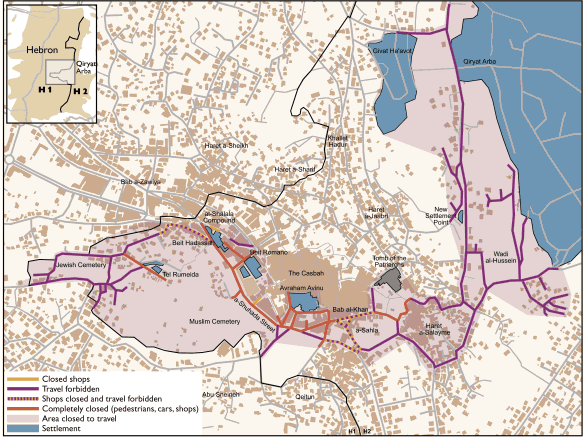
[Map of al-Khalil, showing Israeli settlements and restrictions on Palestinians. Image by B`Tselem.]
Arriving at the Checkpoint
Before arriving at al-Khalil, I had to get a ride early in the morning from a friend who is originally from ‘Arabeh and currently lives in Beit-Safafa. We drove through the Israeli checkpoint in Bethlehem. He told me how he makes a point of shopping in Bethlehem to benefit the Palestinian economy. He described how, at times, the Israeli soldiers give him a hard time as he tries to re-enter Israel, and how they restrict the quantity of grape leaves and other agricultural goods that he is allowed to bring back with him.
My friend also shared the story of how he was stopped a year ago at the Qalandiya checkpoint while he was driving to East Jerusalem with his wife and her sister. The Israeli soldier told him that he could only have his wife go through with him, as they were related, but not her sister. His wife immediately asked to switch to the driver’s seat, so the Israeli soldier had to let them through since then, as the driver, both her husband and her sister were related to her.
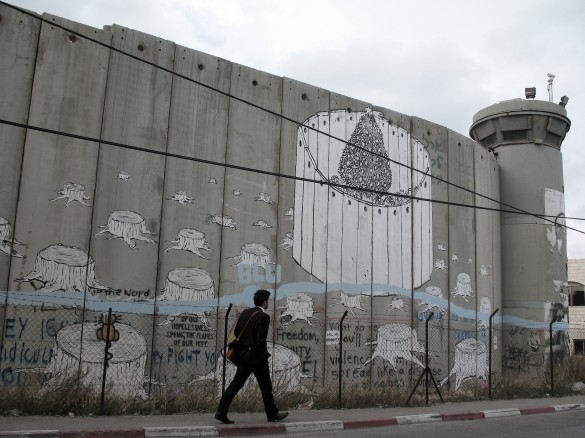
[The Wall in Bethlehem, close to the checkpoint from Jerusalem. Image by Diego Segatto]
As we approached Bethlehem, we were confronted with giant concrete walls and barriers. This was an ugly reminder of how the Israeli Separation Wall has engulfed Bethlehem, and symbolically marked the start of my trip to al-Khalil. I quickly found a place in an old mini-bus that drove me and other students to al-Khalil.
An Encounter with al-Khalil
On reaching al-Khalil, I had no plan of where to go or what to do. I asked for directions to get to the old part of the city and started walking through the market. Speaking to a woman running a store that sells Palestinian embroidery, I explained the aim of my visit and she immediately put me in touch with the son of a family whose neighbors are Jewish Israeli settlers.
I went to the roof of the family’s house, and could see Israeli soldiers on guard on adjacent rooftops. The mother described how they had to put up nets to prevent their settler neighbors from throwing trash on their house. She also described the vast amount of money they were offered to sell their house to the settlers.
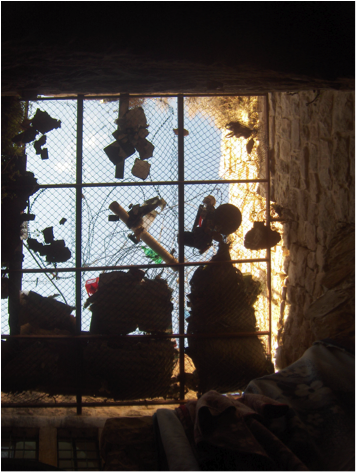
[Old city rooftops. Image by Isis Nusair.]
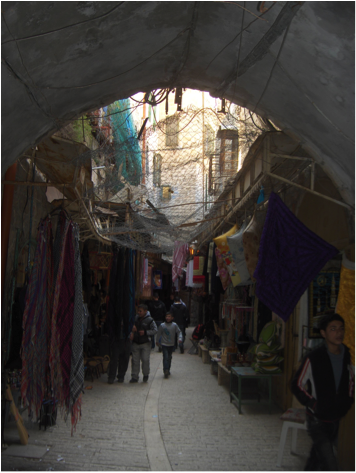
[Old market in al-Khalil. Image by Isis Nusair.]
I had the chance to meet with representatives of the Christian Peacemakers Team (CPT), and they introduced me to a woman activist who invited me into her house to see her balcony overlooking al-Shuhada (Martyrs) Street. Representatives of the Temporary International Presence in Hebron (TIPH) had placed metal barriers on her windows to protect her house from the stones of the settlers. Needless to say, she could no longer enjoy her balcony!
.png)
[Overlooking al-Shuhada Street. Image by Isis Nusair.]
.png)
[Overlooking al-Shuhada Street. Image by Isis Nusair.]
I continued walking in the old market until I reached another barrier where I could see more Israeli soldiers. I realized then that I must have arrived at the Ibrahimi Mosque. There was a triangle of Israeli barriers and checkpoints. I exited through one, went through another to get into the mosque, and then passed by a third as I started walking towards the area in the heart of the city where Israeli settlers live.
Entering the Enclave
The emptiness of the settlers’ area in comparison to the buzzing activity in the old city was eerie.
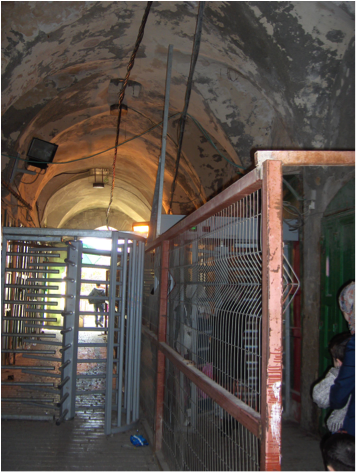
[Israeli security checkpoint by the Ibrahimi Mosque. Image by Isis Nusair.]
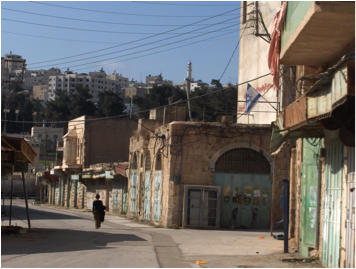
[Walking in the Israeli Settler controlled area in al-Khalil. Image by Isis Nusair.]
I continued walking until I arrived at an intersection and did not know where to go. I asked an Israeli soldier on-guard on how to get to Beit-Hadassah. He pointed in the direction.

[Israeli security tower at the entrance to al-Shuhada Street. Image by Isis Nusair.]
I felt terrified, as anything could happen in this seemingly forgotten and empty place. There was hardly anyone around except for a few settlers who were waiting for the bus and a lone Israeli soldier on guard.
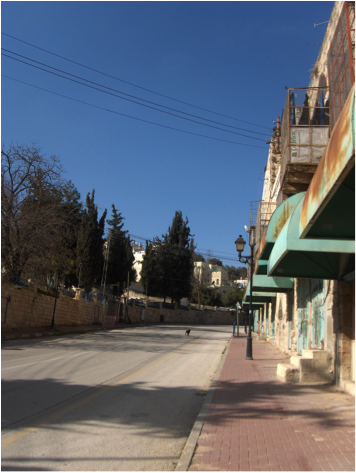
[al-Shuhada Street. Image by Isis Nusair.]
All Palestinian stores were closed and I passed by what was once a vibrant vegetable market that had become completely lifeless except for a few cats.
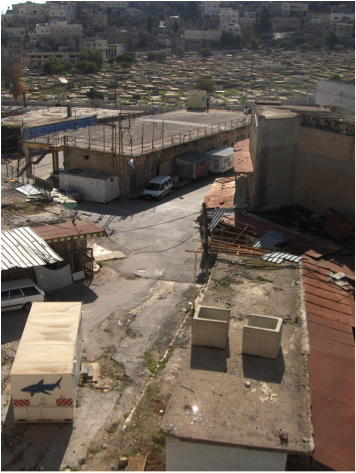
[The old vegetable market. Image by Isis Nusair.]
Before arriving at Beit-Hadassah/al-Dabbuya, the heart of the settler enclave in al-Khalil, I wanted to take a picture of a concrete barrier that I had been on the other side of (that is the Palestinian side) less than an hour before.
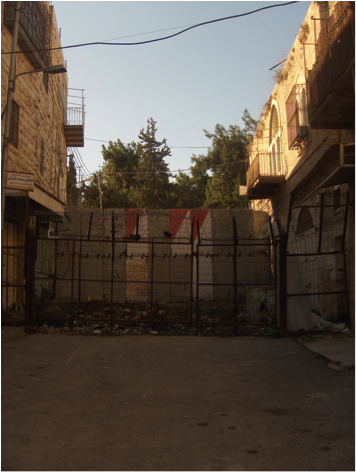
[The Israeli security barrier from the Palestinian side. The Hebrew graffiti on the wall reads "Neighborhood of the heroes of Hebron." Image by Isis Nusair.]
At that moment, my camera refused to cooperate. I am not sure if it was my fear that affected its function or a mere coincidence. I passed by Beit-Hadassah/al-Dabbuya and continued walking until I arrived at another Israeli checkpoint. I wanted to go through but was prevented by the soldiers “for my protection” as I am a (Palestinian, second-class) citizen of Israel. I told them that I wanted to go through, back to the Palestinian section of town as it made no sense to return the way I came when the Palestinian section was less than a minute walk away. After I insisted that I wanted to go through, the soldier asked whether I was Arab, and when I answered in the affirmative, he allowed me to go through, but threatened: “Hope they don’t do anything to you” (shelo ya’asou lach mashehu).
I would have liked to think that by leaving the settler area, my trip to al-Khalil was over, but I was yet to exit the whole city back to Jerusalem, rather than just the Israeli Jewish enclave within an enclave.
Returning to Jerusalem
When looking for public transportation, I was faced with two options: either take a cab via the Israeli tunnel straight to Jerusalem, or take the bus via Bethlehem back to Jerusalem. I ended up taking the bus, and had to go through one last Israeli checkpoint before arriving into Jerusalem. The bus was stopped. A young Israeli female soldier got on board and asked very arrogantly in Hebrew (with a strong Russian accent) that we get off the bus. She rudely asked the driver: “What is this, a summer camp?” (ma zeh kaytana?), as there were many children on board the bus, and—according to Israeli regulations—women with children were exempt from getting off the bus.
Although I traveled on my own, I refused to get off and was bluntly told by the same soldier that if I did not get off, I would not be able to enter into Jerusalem. Before I exited the backdoor, I told her in Hebrew: “Enjoy your fake power” (tehani mehakoah hamezouyaf shelach). She was not happy with my comment, and was waiting for me outside when the time came to check my bag before letting me back on the bus. By then, she had decided to call her superior to complain that I had cursed at her.
The word “fake” in Hebrew is mezouyaf, and the word for “fucked” (and in certain contexts “armed”) is mezouyan. I insisted that I did not curse her and that all I had said was “enjoy your fake power.” Her superior let me through, perhaps due to the “easing of regulations” in Bethlehem a day before Christmas Eve for Greek Orthodox Palestinians. At that moment, I took a deep breath, feeling suffocated by my face-to-face encounter with this brutal politics of control, discrimination, and segregation.
Returning to al-Khalil
I returned to al-Khalil with my Palestinian friend in early May 2012. This time, we drove together through Beit-Jala and were able to witness another unsightly extension of the Separation Wall. As my friend had her two young children with her, she decided that it was not safe to come with me to the area controlled by Israeli settlers. I walked there on my own to continue taking pictures from the point where my camera had stopped functioning a few months earlier.
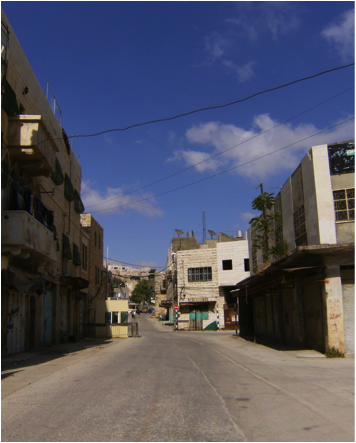
[Walking into the Israeli settler controlled area. Image by Isis Nusair.]
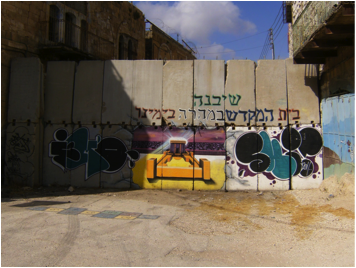
[The other side of the barrier. Hebrew graffiti reads “So that the temple shall be built quickly in our time.” Image by Isis Nusair.]
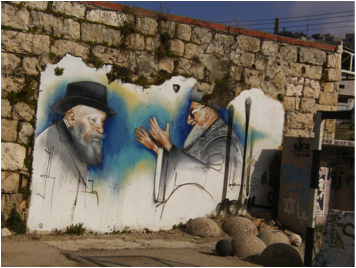
[Mural of Israeli rabbis Dov Lior and Mordechai Eliyahu next to the deserted vegetable market. . Image by Isis Nusair.]
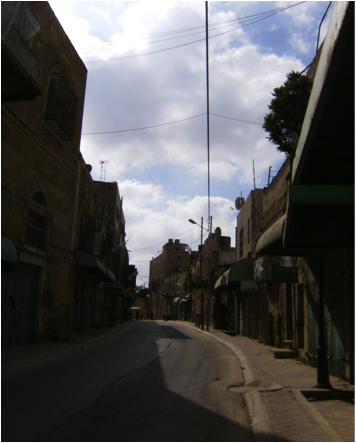
[Walking on al-Shuhada Street. Image by Isis Nusair.]
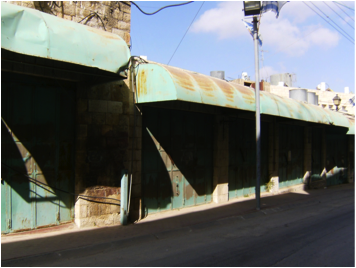
[Walking on al-Shuhada Street. Image by Isis Nusair.]
A Jewish Israeli child was happily driving his small motorcar on the road, and there were tour buses as well as Israeli soldiers on patrol on al-Shuhada Street. Nobody said anything to me, and I was on a mission, still afraid, yet not as much as I had been during the first trip since I at least knew where to go. I did not dare enter into Beit-Hadassah/al-Dabbuya, still feeling suffocated by the eerie atmosphere of the enforced closure of that major part of the city to accommodate just a few hundred Jewish settlers.

[Beit Hadassah/al-Dabbuya. Image by Isis Nusair.]

[A child playing next to Beit Hadassah/al-Dabbuya.]
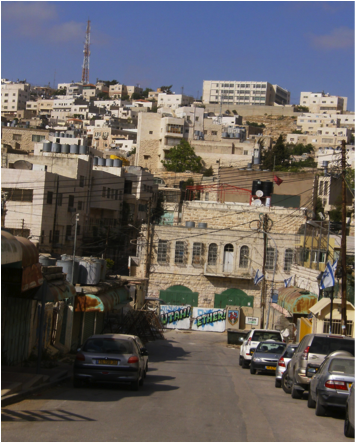
[Barrier separating the Palestinian and Jewish parts of the city. Image by Isis Nusair.]
As I was going back to the Palestinian area, this time walking back the way I came in order to meet my friend by the mosque, I passed by closed shops and signs detailing where the taxi stop, hammam, cinema, barbershop, and grocery store used to be.
.png)
[Deserted taxi stop. Image by Isis Nusair.]
.png)
[Deserted taxi stop. Image by Isis Nusair.]
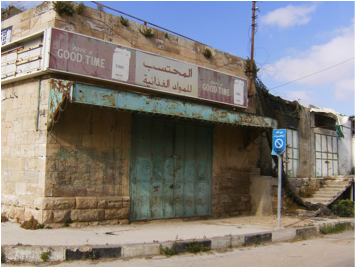
[Deserted grocery store. Image by Isis Nusair.]

[Hammam Al-Naim. Image by Isis Nusair.]
I kept imagining how buzzing and vibrant this area must have been before 1979. I passed by a small mosque that was open with hardly anyone inside. I also passed a group of Palestinian kids who were playing by a concrete Separation Wall that reminds me every time I see it of similar barriers at the Lvov and Warsaw Ghettos, etched in my mind through films such as The Pianist and In Darkness.
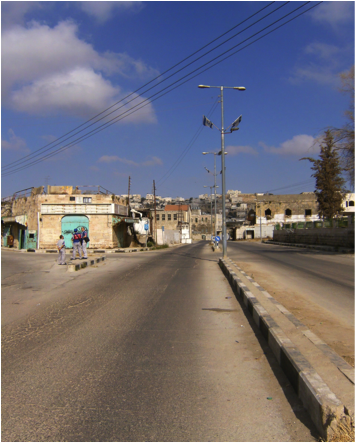
[Temporary International Presence in Hebron (TIPH). Image by Isis Nusair.]
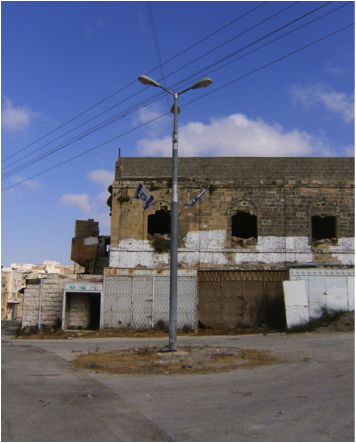
[Settler controlled area in al-Khalil. Image by Isis Nusair.]
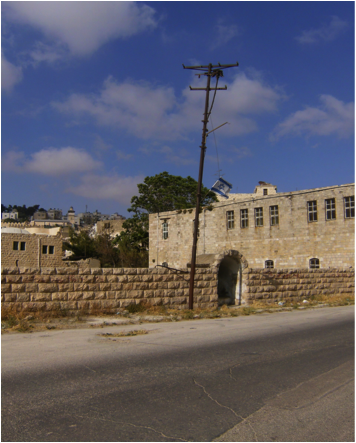
[Settler controlled area in al-Khalil. Image by Isis Nusair.]

[Settler controlled area in al-Khalil. Image by Isis Nusair.]
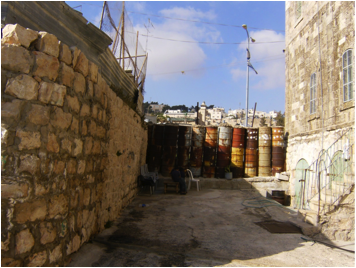
[Palestinian kids playing by a concrete barrier. Image by Isis Nusair.]
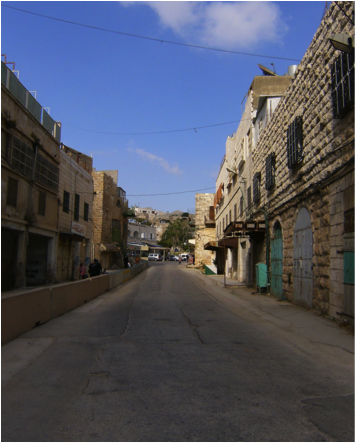
[Returning to the Palestinian section of town. Image by Isis Nusair.]
[This article is a co-publication, also appearing on arenaofspeculation.org]